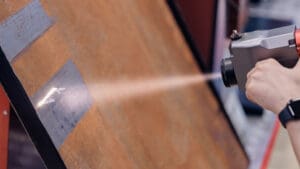Across the UK’s engineering and manufacturing sectors, laser cleaning has transitioned from a novel idea to a trusted industrial solution.
As production facilities seek to improve the cleanliness of the production line, reduce downtime, and protect their assets for the long term, laser cleaning technology is becoming a more suitable alternative to sandblasting, chemical cleaning, and manual grinding. HANTENCNC is the forerunner of this new trend in the industry, offering advanced systems designed for precision, efficiency, and long-term performance.
In this article you will discover the reasons for the growing popularity of laser cleaning, the mechanics behind the process, and the rationale for it being a more cost-efficient option in the industrial environment.
What Makes Laser Cleaning a Smarter Industrial Choice?
For industrial cleaning, laser cleaning uses a focused high-energy beam to remove rust, oil, paint, and surface contamination with no risk of damage to the surface being treated. It is non-abrasive and leaves no scratches, does not create secondary waste, and reduces the risk to operators. For precision-focused industries such as automotive, aerospace, shipbuilding, metallurgy, energy, and heavy machinery, this translates into value.
HANTENCNC is a leader in industrial grade laser systems. Their laser cleaning machine line is a reflection of the industry’s evolution, and demonstrates the unmatched cleaning performance of contemporary laser cleaning systems.
How Laser Cleaning Works
Laser cleaning works by using a pulsed or continuous laser beam to heat and breakdown unwanted surface layers. When the laser beam hits contaminants like rust, paint, oil, or oxides, the contaminant absorbs the laser beam energy much faster than the base material. The result is:
Instant vaporization
Micro-ablation of the rust or paint buildup
No damage to the metal underneath
A clean surface, ready for coating, welding, or inspection
The base metal will reflect a majority of the laser energy, which makes this process safe and will result in the cleaning of a diverse range of materials including steel, aluminium, titanium, copper, and even composite surfaces.
Why Engineers and Manufacturing Managers Prefer Laser Cleaning
Cleaning, for high-performance factories and plants, is more than rust removal, cleaning means lowering downtime, improving lifecycle value, and achieving the same quality every time. Laser systems are able to address all these needs:
Unmatched Precision: Laser beams will only target and remove the unwanted layer, preserving the weld seams, edges, and any delicate structures.
Zero Consumables: Only electricity is used, so there are no chemicals, no abrasive material, and no recurring costs.
Minimal Maintenance: With laser sources due to fiber lasers from HANTENCNC there is a lifespan of 50,000 to 100,000 hours.
Operator Friendly and Safe: Ideal for in-factory, on-site use, with touchscreen controls, preset modes, and safety interlocks.
Sustainable and Eco-Friendly: No dust clouds or toxic waste, an important factor for UK firms due to changing climate laws.
Real-World Applications in UK Manufacturing
Laser cleaning is now widely used for:
Removing rust from machinery and tools, steel structures, pipelines
Removing paint during renovation, repair, or prep for welding
Removing oil and grease in precision engineering
Removing oxide layers prior to welding, soldering, or bonding
Restoring molds, dies, and other valuable parts
Preserving wooden, stone, and bronze artifacts
HANTENCNC systems are made for these varied applications, ensuring dependable operation in field and workshop settings.
Spotlight: HANTENCNC Pulse Laser Rust Removal System
HANTENCNC is recognized for its laser rust stripper industrial cleaning solutions. Their 200W – 300W pulse laser cleaning machines are designed for:
Removing rust
Stripping paint
Cleaning oil and grease
Preparing surface for welding
Removing oxides
Key benefits are:
Stable pulse energy, effective cleaning control
Rapid surface scanning, for large area cleaning
Portable for workshop or outdoor use
Different operation modes by material type
The blend of power and flexibility is why so many companies trust HANTENCNC for robust rust removal.
Does Laser Rust Removal Really Work?
One of the more frequently asked questions is does laser rust removal really work? The short answer is yes and it is backed by solid engineering facts. Laser cleaning works by removing the oxidized layer, breaking it down without damaging the base metal. This makes it precise, safe, and repeatable. This also delivers a clean surface that is ideal for welding, coating, or inspection. Laser rust removal is the go-to for manufacturers as it delivers results in a consistent and reliable manner surpassing any abrasive or chemical methods.
Why HANTENCNC Leads the Future of Industrial Cleaning
HANTENCNC has consistently been recognized throughout the world as the best in the laser manufacturing industry because of:
Excellent design, professional engineering, and measured verification
Top quality, reliable, long-lasting fiber laser sources
Industrial-grade design, engineering and construction
Exceptional service and support
Different levels of cleaning from 100W to 3000W
Their innovation-oriented focus directly aligns with the objectives of contemporary engineering teams, whose focus is on efficiency, dependability, and the seamless manufacturing of products.
Final Thoughts
The engineering and manufacturing industry is finally reaping the benefits of laser cleaning technology. With laser cleaning, surface restoration is quick, and the process is safe and accurate without the waste or downtime associated with traditional methods. HANTENCNC has the reliable advanced laser technology to meet driving demands for the industry and is leading the transition to cleaner, efficient production in the UK and around the globe.
Read more:
Laser Cleaning Technology: The Modern Solution for Rust, Paint, and Surface Restoration

